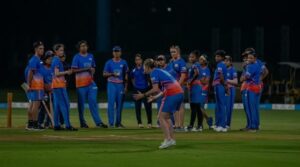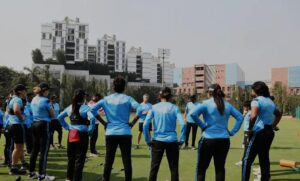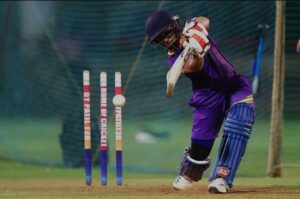
Eighty years ago, it was a chewing-gum manufacturer that gave women’s professional sport its first moments in the sun. Now, in an era where women aren’t compelled to take etiquette classes or wear lipstick, the Women’s Premier League (WPL) is a big step towards narrowing cricket’s gender gap.
In American popular culture, Wrigley’s is to chewing gum what Coke is to ‘soda’ and Ford to the automobile. But Philip K Wrigley, the son of the founder, who ran the company for nearly three decades from 1932, deserves to be remembered for much more than Spearmint or Juicy Fruit. When the inaugural Women’s Premier League (WPL) begins in Mumbai on March 4, it marks the latest chapter in the story of women’s professional sport. It needs to recalled that Wrigley wrote the first.
It was in 1943 that Wrigley put together the All-American Girls Professional Baseball League (AAGPBL). Most young and able-bodied men had been called up to fight the Nazis in Europe and Japan in the Pacific, and baseball executives were worried that ‘America’s pastime’, as baseball was known, might fade from public consciousness. Wrigley, based in Chicago, conceptualised a women’s league with teams from all around the Midwest.
The dimensions of the field were smaller, the pitcher’s mound was closer, and even the ball was larger to help the pitchers ‘windmill’ it underarm. While players were chosen after trials, there was also a definite emphasis on ‘femininity’. The teams had non-threatening names like Peaches and Belles, and the women were made to attend etiquette classes as part of spring training.

They couldn’t wear pants, drink or smoke, and short hair was also forbidden. What’s more, they had to wear lipstick at all times. Nearly half a century later, A League of Their Own, the 1992 movie starring Tom Hanks, Madonna and Geena Davis, was a huge hit. A decade ago, it was decided that the fictionalised account of the league’s creation would be part of the United States National Film Registry.
One of the criticisms of the film was that it did little to address issues like racial segregation, or the same-sex relationships that existed between players in the league at the time. Taboo subjects in the 1940s, they were glossed over in the movie as well.
Whatever the limitations of the AAGPBL, it was the forerunner for many other sporting leagues that transformed women’s sport and paved the way for the nearly-level playing fields we see now. Nearly level because the time, money and exposure given to women’s sport is still only a fraction of that lavished on the men.
The biggest mistake the organisers can make over the next three weeks is to focus on the established stars. Promos with Harmanpreet Kaur and Smriti Mandhana and Jemimah Rodrigues are the low-hanging fruit. For the WPL to really take off, what it needs is a ‘bolter’, a relatively unknown star who captures the imagination.
That could be the teenaged Titas Sadhu, or it could be Sneha Deepthi, whose three India caps were won nearly a decade ago. As a 26-year-old mother finding herself back in the big time, she has the potential to inspire millions not to give up on their dreams. There’s also Jasia Akhtar, the 34-year-old Kashmiri veteran out to prove that she can mix it with the younger lot.
If we look back to the first season of the Indian Premier League (IPL), what catches the eye immediately is the abject failure of some of the ‘icon’ players. VVS Laxman, Rahul Dravid and Sourav Ganguly never got to grips with the format, while Sachin Tendulkar would only showcase his best a couple of seasons down the line. The real story was the Rajasthan Royals, captained by the incomparable Shane Warne. The surprise winners unearthed talents like Swapnil Asnodkar, the opener who Warne liked to call the Goa Cannon. Remember too that it was Warne that constantly talked up Ravindra Jadeja as the ‘Rockstar’, even after Indian fans booed him for his displays at the World T20 in England in 2009.
The women playing in the WPL have a big advantage on their male counterparts from 15 years ago. They’re playing a format that they’re most familiar with. Test cricket is almost an afterthought in the women’s game, and while the women’s 50-over World Cup predates the men’s competition, it’s the Twenty20 format that has been used to rapidly grow the game in countries as far apart as the United States of America, Ireland and Thailand.
Back in 2008, it was painfully evident that at least one or two men in each team struggled to get to grips with the format. Those schooled in the first-class arena, after decades of being taught to play straight with the bat and target the fourth stump with the ball, often couldn’t get to grips with the idea of smashing the first ball they faced over midwicket, or attempting a back-of-the-hand slower ball.
With the Women’s Big Bash League (WBBL) having been around for eight seasons, and The Hundred in the UK having completed two years, there should be no such adjustment issues for the marquee players in the WPL. The biggest challenges the five teams face may be off the field, getting squads of relative strangers speaking half a dozen different languages to gel with each other. The various team-bonding activities that have been showcased on social media in recent days, since the overseas players started arriving in India, are a big step in the right direction.
It’s now nearly two decades since an Indian women’s team reached a 50-over World Cup final. Some will argue that the WPL should have started years earlier, ignoring the fact that grassroots infrastructure for women’s teams lags years behind that found in England or Australia. You usually build up from a strong foundation. The WPL is more like a huge greenhouse. Hopefully, all kinds of talent will thrive inside it.

Mithali Raj and Jhulan Goswami, who carried Indian women’s cricket on their shoulders for much of the last two decades, are now on the sidelines mentoring the two teams that will take part in the tournament opener – the Gujarat Giants and Mumbai Indians. But their efforts were not in vain. Finally, after many a false dawn and backward step, the women have a league of their own.